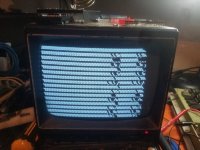OK, lets see what I can suggest. First lets see if we can isolate a few things and then run some test.
First what is going on.
First, how the dang thing works. Looking at the screen, you have 64 characters wide by 16 lines. That is 1K bytes of data. The RAMs are one bit wide so likely have one bit of each character for each address location of each RAM. The full width of RAMs would have the full character for one address. The output then likely go to A0 to A6 of the MCM6571A ( the font ROM ). The character on the screen is created by bits from the ROM. Each bit is access by ROW and column( look at the data sheet for the ). With each count of the RS0 to RS3, it produces one complete row of, of one character, to the D0 to D6. These bit would need to be serialized to the video out. I suspect that is one of the parallel in to serial out shift registers. It could also be done by a 8 to 1 mux but this would require a faster access time of the character ROM.
I suspect the shift register. Each row is sequentially accessed for each horizontal sweep each row of the RS0 to RS3.
It looks like this part of the circuit is basically working as we get a $ for most of the characters. The shift registers are likely working fine.
The fact that we see a constant row of $ with about the last 22 characters are different leads me to believe that at least 1/2 of the RAM is being accessed during the display sweep. It is most likely that were are seeing some part of the RAM. I then suspect the issue may be related to the writing of the RAM. In order to access the RAM, independently of the video sweep, we need some way to have different addresses for the write and for the read. For this, there should be mux input for the 10 address lines going into the RAM. I suspect that is the purpose of the 74157s. There are two possibilities here. One is that it waits for the vertical retrace to update the typed character. This is unlikely. Next is that if there is an incoming character, it just takes the address away from the video and writes the character ( typically done on many early videos ).
I will repeat, you need to connect the serial out to the serial in of the TVT. You can keep the clock and ground hooked up to your CPU but we really need to control the data going in more directly.
When you type ca character, we should be seeing pin1 of the 74157 toggle and see pin 3 of the RAMs toggle.
Check that and report back what you see( also is there any change on the screen? )
Dwight

